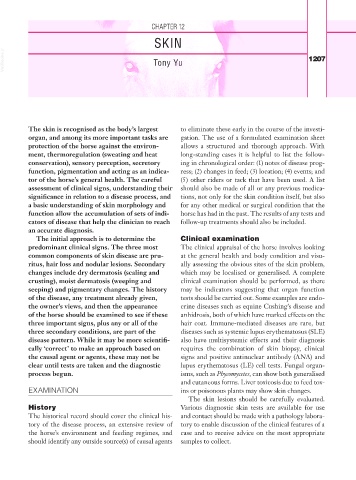Page 1232 - Equine Clinical Medicine, Surgery and Reproduction, 2nd Edition
P. 1232
CHAPTER 12
SKIN
VetBooks.ir Tony Yu 1207
The skin is recognised as the body’s largest to eliminate these early in the course of the investi-
organ, and among its more important tasks are gation. The use of a formulated examination sheet
protection of the horse against the environ- allows a structured and thorough approach. With
ment, thermoregulation (sweating and heat long-standing cases it is helpful to list the follow-
conservation), sensory perception, secretory ing in chronological order: (1) notes of disease prog-
function, pigmentation and acting as an indica- ress; (2) changes in feed; (3) location; (4) events; and
tor of the horse’s general health. The careful (5) other riders or tack that have been used. A list
assessment of clinical signs, understanding their should also be made of all or any previous medica-
significance in relation to a disease process, and tions, not only for the skin condition itself, but also
a basic understanding of skin morphology and for any other medical or surgical condition that the
function allow the accumulation of sets of indi- horse has had in the past. The results of any tests and
cators of disease that help the clinician to reach follow-up treatments should also be included.
an accurate diagnosis.
The initial approach is to determine the Clinical examination
predominant clinical signs. The three most The clinical appraisal of the horse involves looking
common components of skin disease are pru- at the general health and body condition and visu-
ritus, hair loss and nodular lesions. Secondary ally assessing the obvious sites of the skin problem,
changes include dry dermatosis (scaling and which may be localised or generalised. A complete
crusting), moist dermatosis (weeping and clinical examination should be performed, as there
seeping) and pigmentary changes. The history may be indicators suggesting that organ function
of the disease, any treatment already given, tests should be carried out. Some examples are endo-
the owner’s views, and then the appearance crine diseases such as equine Cushing’s disease and
of the horse should be examined to see if these anhidrosis, both of which have marked effects on the
three important signs, plus any or all of the hair coat. Immune-mediated diseases are rare, but
three secondary conditions, are part of the diseases such as systemic lupus erythematosus (SLE)
disease pattern. While it may be more scientifi- also have multisystemic effects and their diagnosis
cally ‘correct’ to make an approach based on requires the combination of skin biopsy, clinical
the causal agent or agents, these may not be signs and positive antinuclear antibody (ANA) and
clear until tests are taken and the diagnostic lupus erythematosus (LE) cell tests. Fungal organ-
process begun. isms, such as Phycomycetes, can show both generalised
and cutaneous forms. Liver toxicosis due to feed tox-
EXAMINATION ins or poisonous plants may show skin changes.
The skin lesions should be carefully evaluated.
History Various diagnostic skin tests are available for use
The historical record should cover the clinical his- and contact should be made with a pathology labora-
tory of the disease process, an extensive review of tory to enable discussion of the clinical features of a
the horse’s environment and feeding regimes, and case and to receive advice on the most appropriate
should identify any outside source(s) of causal agents samples to collect.

